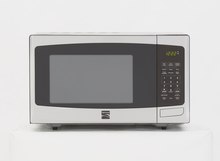Cookbook:Microwave Oven
Cookbook | Recipes | Ingredients | Equipment | Techniques | Cookbook Disambiguation Pages | Cookbook equipment | Kitchen appliances

A microwave oven, sometimes simply referred to as a microwave, is a type of kitchen appliance that heats food using radio waves.
Mechanism
editThe radio waves (specifically, microwaves) emitted by a microwave oven cause water, fat, and sugar molecules in food to vibrate and produce heat inside the food itself. They most often deliver a maximum of between 600 and 1000 watts of energy, with adjustments for time duration and energy output. The energy is safely contained within the oven by a reflective metal box, and thin metallic films/meshes make see-through doors possible. Because of the nature of the microwaves, foods high in moisture as well as the outer regions of food exposed to the microwaves will both tend to heat faster.
Types
edit- Solo microwave ovens: These have a single microwave function and are usually adjustable as to their output and timing. The most common items have a maximum output of between 600 and 750 watts. In addition to output the size of the microwave can be quoted as to its cubic capacity; a fairly large capacity is about 31 litres, but there are many smaller sizes, and a certain amount of the capacity is unavailable for cooking, it being taken up by the rotating turntable.
- Combi microwave ovens: These combine a grilling or browning feature that can work alone or in combination with the normal microwave function. The feature can consist of direct heating elements or heated air jets.
- Sensor microwave ovens: These can be basic or combi, and include automatic weighing of the food contents, so in conjunction with knowledge of the food type, taken from a selector dial, the cooking or thawing time can be worked out automatically. The sensor technologies are still being developed and new ones appear from time to time.
Uses
editMany cooks use microwave ovens to thaw, heat, and/or fully cook foods. In some respects, their scope is more limited than ovens that use direct heating (i.e. gas and electric ovens), but they are very useful for certain specific tasks. Some examples of these tasks include:
- Heating of milk in baby bottles
- Thawing and/or heating pre-cooked food
- Thawing frozen ingredients before cooking
- Popping popcorn
- Softening butter
Tender, moist foods (e.g. ground meat, vegetables, and fruits) can be microwaved on high power. Tougher and lower-moisture foods like eggs, cheese, and solid meat should be microwaved on medium power for a longer period of time to avoid overcooking the outer layers of food.
Techniques
editBecause of the limitations of the waves themselves, microwave ovens work best on small amounts of high-moisture foods, but a variety of techniques can expand their range of uses.
Even heating
editBecause effective heating takes place only in the first 1–2 inches (~2.5–5 cm) of the food, foods should optimally be stirred partway through cooking to evenly distribute the heat throughout the food. Furthermore, both the generation of heat from residual vibration and the conduction of heat from the outer layers of food to the inner layers can continue after the oven is turned off; as such, a short rest period of a few minutes is recommended after removing food from a microwave oven.
Browning
editMicrowaves alone cannot properly brown food, so additional items are used to do so. To make food crisp on its surface, a special plate that is made hot by microwaves is used to hold the food: for example, for bacon, pizza, and to finish 'roast' potatoes. To attain browning of a more general kind (grilling), say for a gratin, the addition of direct heating elements or hot air jets can be used. For those foods that need continuous moisture while they cook, plastic steamers are used.
Containers
editMetals in any amount reflect microwaves, so the containers used during cooking must be transparent to microwaves; that is they are made of materials free of significant traces of metal. Many existing glass and china kitchen items work well in microwave ovens, and some of these are marked as microwave safe. Heating a cup of water (to avoid overloading) along with a dish that is to be tested for suitability, will result in hot water and a cool dish if the item is useful for the microwave, but the dish will be hot if it is not. Note that containers for microwaves might still not survive air jets and grills, so care is needed in their use. A common lid for dishes is a pierced plastic film, some brands of which are more suitable for high temperatures than others.
Safety
editMicrowaving food is typically very safe, as long as certain precautions are followed. A high standard of safety is applied in the manufacture of most modern microwave ovens, ensuring negligible microwave leakage and that safety interlocks prevent the generation of microwaves whenever the door is opened. These safety features are tested for all new products, though there are rarely any compulsory tests for ovens after the point of sale.
Food safety
editCooking large pieces of raw meat, especially if they contain stuffing, is not recommended. Because the microwaves can only penetrate the outer layers of food, the inner layers of uncooked meat may not heat up enough to destroy disease-causing organisms before the outer layers are overcooked.
Additionally, it is not safe to cook any sealed or enclosed food in a microwave oven due to risk of explosions. Eggs in their shells should never be cooked in a microwave oven, and whole potatoes should always be pierced several times prior to heating.
Metal
editBecause metal reflects microwaves, placing metal in a running microwave oven can result in electrical sparks and arcing. This can damage the oven and is a fire hazard—never leave metal in a running microwave unattended.
See also
editExternal links
edit- https://www.fda.gov/radiation-emitting-products/home-business-and-entertainment-products/microwave-ovens
- https://www.britannica.com/technology/microwave-oven
- https://www.fsis.usda.gov/food-safety/safe-food-handling-and-preparation/food-safety-basics/cooking-microwave-ovens
- https://www.consumerreports.org/appliances/microwave-ovens/buying-guide/
- https://www.cooksinfo.com/microwave-ovens/
- https://www.seriouseats.com/microwave-hacks